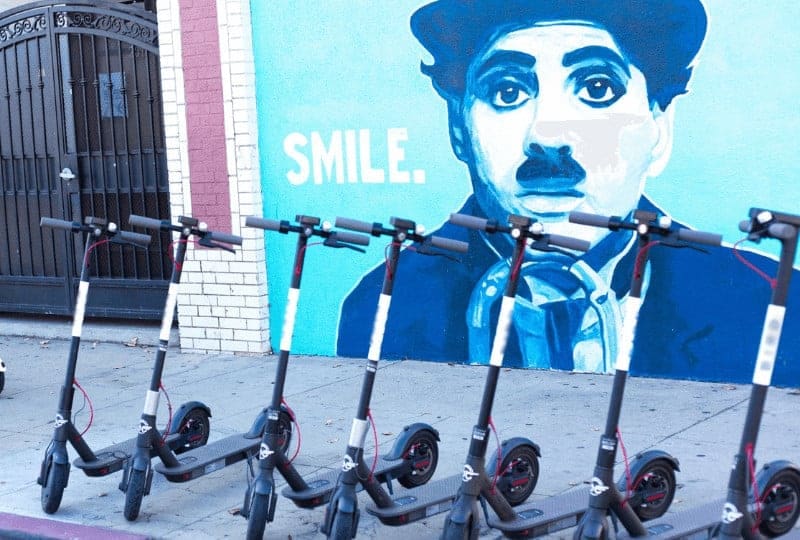E-Scooters Have An Image Problem

E-scooters, like so many other startups, seemed like a great idea at the time. They’re easy to find, fun to use, and cheap to distribute. The idea was that electric scooters would be scattered all over major cities, able of moving much faster than a walking pace on sidewalks or in bike lanes.
If you needed to get from Point A to Point B, you’d just use the app to find the nearest scooter, pay for it, go where you wanted to go, and leave it there for the next person. You didn’t have to buy the scooter, carry it indoors, or worry about maintaining or keeping track of it. Great, right?
Unfortunately, the rise of the e-scooter industry has not been without its speed bumps (sorry, road puns). If the industry is to survive, companies that manufacture e-scooters are going to have to find a way to coexist with the existing urban ecosystem. Here are some of the problems that e-scooters have yet to solve.
E-Scooters Don’t Play Nice With Pedestrians
E-scooters from trendily-named companies like Lime, Bird, Scoot, and Skip are different from city bike programs in that they’re what’s called “dockless.” They don’t need to be left at a particular location when the user is finished with them. Instead, users can just leave the scooter wherever they want — and that’s exactly what they’re doing.
The mayor of San Jose, where these scooters have started to become popular, has been inundated with complaints about scooters left haphazardly in bike lanes and sidewalks or leaned against private property. Some cities have experimented with dedicating parking spaces as scooter parking or with continuing to charge users until the scooter is properly docked, but there’s no consistent solution yet.
Then there’s the question of speed. Some e-scooter brands advertise that their vehicles can travel at speeds up to 25 miles an hour — a surprisingly fast pace even for a wide open bike path, let alone a crowded sidewalk. The scooters aren’t terribly maneuverable and don’t brake quickly, so the prospect of pedestrian collisions is a real concern.
Are E-Scooters Even Safe?
It’s not just collisions with pedestrians that scooter-friendly cities have to worry about — it’s the safety of the riders themselves. In May of this year, the Center for Disease Control (CDC) investigated the safety risks of e-scooters at the behest of Austin’s Transportation Department and Public Health agencies, which requested that it investigate the surge in accidents they’d been seeing.
The results were perhaps unsurprising — 45 percent of e-scooter accidents resulted in head injuries, compounded by the fact that less than one percent of e-scooter riders wear helmets when they use them. The second most common injury was arm fractures, often caused by riders trying to catch themselves when they fall.
Scooter companies are in an uncomfortable position. On the one hand, they want to endorse safety — Lime offered 250,000 free helmets to people who took their safety pledge — but on the other hand, the use case they have in mind for scooters isn’t the same as a bike commuter. Scooters are supposed to bridge the gap between the subway station and the office or to be a spontaneous way to get downtown, and people don’t carry helmets with them all the time.
Finally, there’s the question of fire. Just as the rise in so-called “hoverboards” was cut short by fires in low-quality lithium-ion batteries, e-scooters have had their share of concerns. In October of 2018, Lime recalled several thousand scooters over the risk of fire in their batteries. Lithium-ion batteries are susceptible to smoldering or burning when damaged — given that it’s impossible for e-scooter companies to keep track of how their scooters are treated, risk management will always be difficult.
E-Scooter Companies Are Engaging In Controversial Labor Practices
In May, Uber and Lyft drivers across the country went on “strike,” protesting the fact that they’re classified as independent contractors and thus not subject to the same legal protections as hired workers. We put “strike” in quotation marks because according to Uber, these drivers aren’t even employees — they’re customers.
Ride-sharing companies have been in hot water over their seeming abuse of the independent contractor classification for a long time, and it seems that e-scooter companies might be following suit. When an e-scooter’s battery dies, someone has to find it and bring it to a charging station, and the scooter company Bird has been classifying those workers as independent contractors.
The problem is that the classification allows them to pay a flat $5 rate per scooter collected, which often isn’t enough to cover the cost of finding it and transporting it in the first place. A lawsuit was recently filed in California arguing that scooter collectors should be classified as employees, not independent contractors.
The Future Of E-Scooters
It’s possible that these are simply the growing pains of a fledgling industry. But analysts have argued that the entire business model is unsustainable as maintenance costs catch up and businesses scale. If e-scooters are going to usher in the next era of urban transportation, they’ve got some work to do.





